Tim Tebow Believes. Do You?
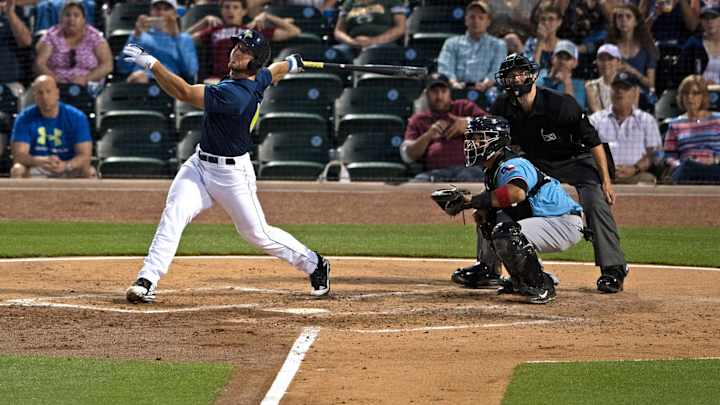
It was a pleasant spring night in Columbia, S.C., and all around the ballpark the familiar pattern of minor league baseball had set in. Groups of twentysomethings were drinking at the beer garden in centerfield, children were playing in the bouncy house in left, devoted parents were waiting in the long line for Dippin’ Dots. The Columbia Fireflies were playing the Hickory Crawdads in a Class-A South Atlantic League game, and the Fireflies were losing to the Crawdads late, 4-1.
Just then, down in the Fireflies dugout, Tim Tebow sidled next to Joel Fuentes, the Fireflies’ hitting coach, and informed him that this was the first time they had trailed in a game all season. And it was getting Tebow fired up. That’s going to happen, Fuentes. You know, what? This is a good challenge. Let’s go! We’re going to come back AND SHOW THEM HOW GOOD WE ARE!
Tebow had his chance soon enough. He came to bat in the bottom of the ninth, with the Fireflies trailing by four now, the bases empty and the crowd having thinned out. Many people had stuck around just to see him. They pulled out camera phones and tried to get a good view.
On the first pitch, Tebow was swinging for the fences and … he missed. Then he took a ball, and fouled another pitch back. One-two count.
Tebow stepped out, took a breath and then dug back in. Here came the windup and the pitch: a breaking ball, heading for the outside corner. Tebow checked his swing—and the umpire threw out his fist. Strike three. Tebow stood there for a moment, pleading with the ump. Then he trudged back to the dugout, his bat under his arm and his head hung low.
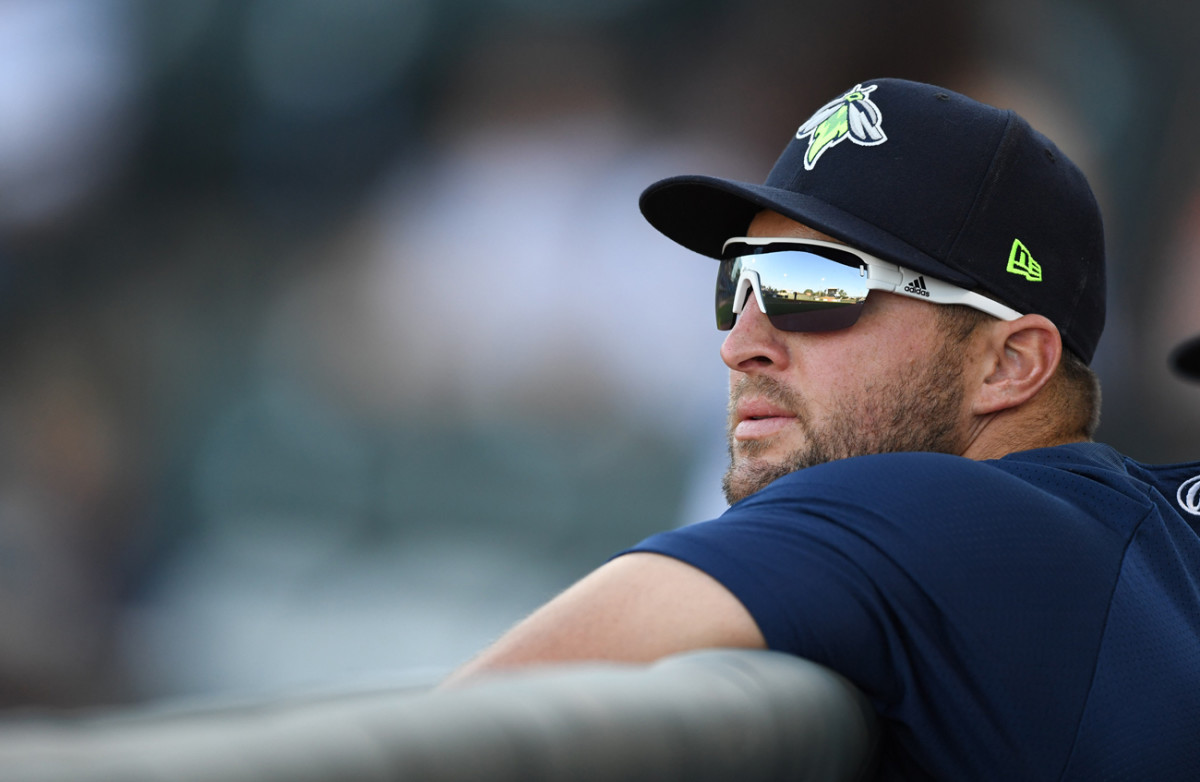
Now, if you were in the stands that night, watching that scene unfold, there was a good chance you processed it differently from the person sitting next to you. Maybe you saw Tebow getting fired up in the dugout and thought to yourself, How inspiring is that, that he cares that much about winning this game. Or maybe all you saw was Tebow strike out in front of a few thousand people in a Class-A minor league game, and you thought, How sorry, how… sad … this all looked.
• PETER KING’S POST-DRAFT MAILBAG: More from the 49ers’ draft room, plus your questions on the draft
There always seems to be this divide with Tebow, a divide that began back in his college days, when he rose to fame for playing football and professing his faith. It’s the divide between the way Tebow views himself and the way the rest of the world does. On one side we have Tebow, the dreamer, the ultimate believer, and his band of disciples. And on the other side, we have … well, it’s more complicated.
There are the cynics and critics, of course—people who just can’t stand Tebow. But there are also the Realists—smart, rational people who see Tebow’s actions sometimes and can’t exactly square them. The Realist is probably the person whom most of us identify with. The Realist is the observer asking questions with a healthy dose of skepticism. The Realist is the one who left the park that night, wondering, Why is Tim Tebow playing baseball?
To which Tebow responds, “Why not? Why does everything start out with a negative connotation? Unfortunately sometimes we look at things in a negative way, rather than striving for what we want to do, and what we believe in, and lifting each other up, and building each other up…” He’s getting fired up again.
“Gosh, that’s someone that I want to be.”
* * *
Tebow first broached the idea of playing baseball more than two years ago. It was March 2015, and he was in a conference room at the Creative Artists Agency offices in the Chrysler Building in New York. He was there with his inner circle: family, friends, agents—all the people who ran his professional life. The agency had called the meeting because it typically schedules regular state-of-the-union sessions with its biggest clients. But this one felt particularly momentous.
Tebow had been sitting idle as an NFL free agent for 18 months, and no team had shown interest in signing him as a quarterback. He seemed to finally be accepting that his NFL career was over. Now his team was asking openly: What’s next for Tim Tebow?
They went around the room throwing out ideas. What about movies? Politics? Books? Someone even suggested that he lead a religious crusade of sorts, traveling the country with pastors and musicians, putting on speaking events and preaching the word of God.
Tebow listened quietly. In a way, his post-football life had already begun. In the past year he’d started working as an ESPN college football analyst, he’d focused more on his foundation, and he’d been traveling doing speaking events. He was transforming himself from Tim Tebow, football player, into Tim Tebow, the … what? He wasn’t exactly sure. What was he passionate about? What gave him that same fire that football had? Nothing they were discussing now stirred in him that feeling.
During a break in conversation, he finally spoke up.
What if I tried playing baseball, he asked, and his heart leapt a little.
He had taken so many swings that blisters on his hands had burst open. Blood was gushing from his palms.
The mood in the room shifted. Baseball? Really? Tebow hadn’t played since high school. Still, a few moments later, they had Brodie Van Wagenen, the co-head of CAA’s baseball division, in the room. He was skeptical, too. He decided he’d try and scare Tebow by explaining just how difficult this process would be. Tebow would have to train for months on end just to put on a showcase and hope some big-league team signed him. … Then the slog through the minors would begin, the long bus rides, the motels. … Tebow would make about $1,100 a week, and he’d have to play for weeks, months, probably years before he even sniffed the majors …
This is when the Realist would’ve taken it a step further. He would’ve made it clear that Tebow would never make the majors, that he couldn’t just pick up a sport after 10 years off and reach its highest level. Doing that would require an act of divine intervention. The Realist would’ve asked, Why even try then, Tim?
No one in the room pushed Tebow that far, though.
And Tebow was undeterred. Take a look at me before you kill this idea.
Van Wagenen humored him. He organized a workout for Tebow in Florida alongside a few Cuban prospects, and after putting Tebow through a series of hitting drills, he came away … impressed. Tebow’s swing clearly needed work, but when he connected, he could really drive the ball. After watching a few drills, Van Wagenen asked Tebow if he wanted to stop. He had seen enough, and Tebow hadn’t swung in a while; his hands must have been sore. But Tebow shook him off and kept swinging. He would show Van Wagenen how badly he wanted this. Not until the workout ended did Van Wagenen notice the red seeping through Tebow’s batting gloves. He had taken so many swings that blisters on his hands had burst open, and he’d just kept going. Tebow peeled off the gloves. Blood was gushing from his palms.
* * *
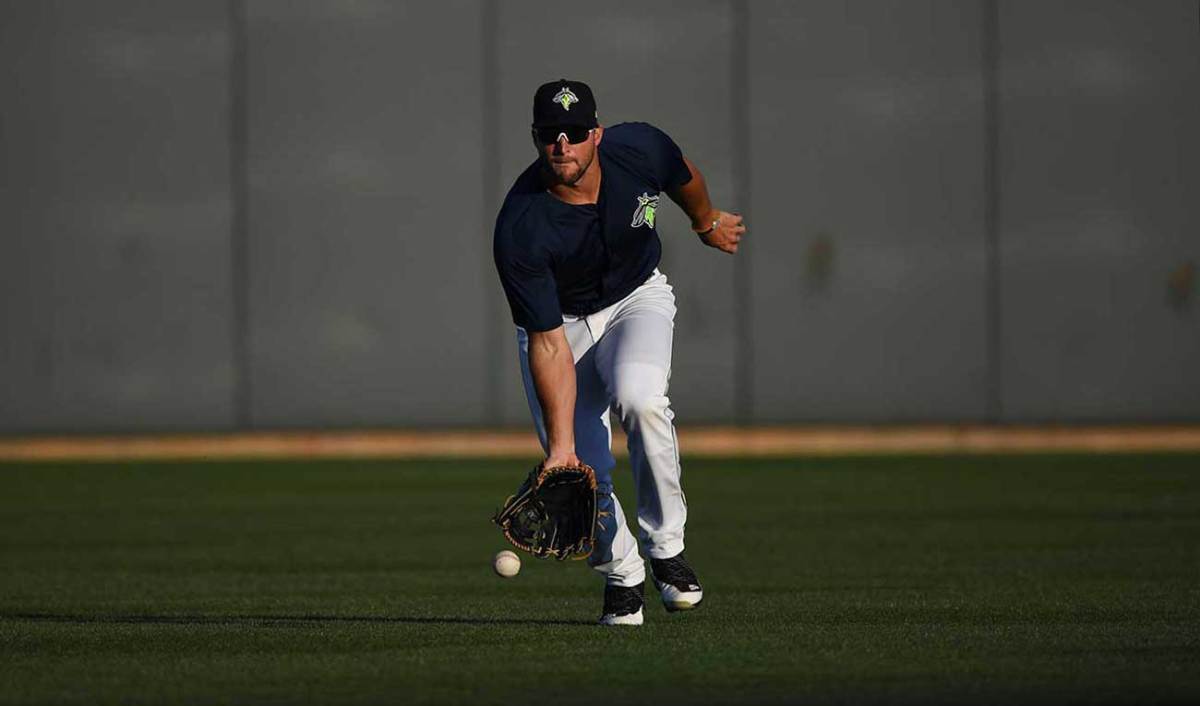
Van Wagenen agreed to take Tebow on as a client—but there was one problem. During their workout, Chip Kelly and the Philadelphia Eagles had called, offering Tebow a chance to play quarterback. That put his baseball idea on hold for a while. Tebow spent the summer with the Eagles, competing for a backup QB job, until he got cut again, at the end of the preseason in September 2015. At that point, Tebow and Van Wagenen decided to wait another year, until after the 2016 MLB draft, before announcing Tebow’s intention to play baseball. That way he could choose his team as a free agent, and he'd have time to train.
They finally scheduled Tebow’s Showcase, his public baseball tryout, for August 2016 at the Southern Cal baseball stadium. It drew a huge crowd: 45 MLB scouts, about 50 media members, and news trucks from NFL Network, MLB Network and ESPN. In the crowd were plenty of Realists, people who doubted Tebow’s baseball ability and wondered if the Showcase was just a gimmick, a public relations stunt, a ploy to keep Tebow relevant in the public eye.
Tebow insisted that his intentions were sincere. He had accepted that his football career was over, but he considered himself still in his prime. He was still only 29. He’d recently switched to a Ketogenic diet, cutting out carbs entirely, and he felt that he was in the best shape of his life. … And, he said, baseball had always been his “first love.” He remembered as a boy being in the backyard with his older brothers, hitting for hours in a batting cage their father had made out of fishing net, dreaming of playing in the majors. He played travel ball as a kid and starred at Nease High in Ponte Verde Beach, Fl., just south of Jacksonville, and he always believed that he could have gone pro in baseball, had he not given it up to play football.
By all accounts, Tebow had thrown himself head first into baseball, too. In May, 2016, about four months before the Showcase, Van Wagenen set him up with Chad Moeller, a retired 11-year big league veteran who would serve as his hitting coach, and they started working on cleaning up Tebow’s swing, making it tighter, more consistent. They worked all through the summer, picking up intensity, Tebow taking upwards of 300 swings a day, bleeding through his batting gloves, talking to himself in the batter’s box. Tim you can do this! Tiiiiim. C’mon, Tim! After he went through a bucket of balls, he’d sprint to pick them up so he could hit again. Everyone kept saying that the only way he would improve was with more reps, more swings, so he kept pushing and pushing and pushing until, a few days before the Showcase … he tore his left oblique.
Now, a few minutes before his big tryout, Tebow lay on a table in a cramped room as his trainer, Ian Danney, worked on his abdominal muscle, and a friend read him Bible verses. Van Wagenen had considered pushing the Showcase back, but there were already enough people who viewed the event as a sham that he feared moving it would bolster the notion. Van Wagenen could hear them now. He’s been training for a few months and he’s already hurt?
No, Tebow had not even considered moving it. He hopped off the table, led his family and friends in a prayer and went to meet the crowd. Some onlookers snickered when they saw him. He was dressed head-to-toe in Adidas, as part of a new baseball sponsorship deal, and his pants looked short and a bit too tight. The workout itself started uneven, too. Tebow ran the 60-yard dash in about 6.7 seconds, which was above average for a baseball prospect. Then he had a subpar showing in the defensive drills in the outfield. Then during batting practice he slugged eight home runs by one writer’s count, sending a few balls into the trees lining the field.
Eight home runs in B.P.? With a torn oblique? If only the scouts knew about the injury, maybe they’d change their minds about him. As a football player Tebow had had a few moments like this, moments when he flashed some ability and made something special happen: those six fourth-quarter comeback wins with the Broncos in 2011, and that 80-yard touchdown pass to beat the Steelers in overtime in the playoffs. His friends and family still pointed to those moments as proof that Tebow was capable of playing in the NFL.
All that remained in the Showcase now was the finale. Of all the drills that day, this would best predict Tebow’s skill as a baseball player. He would face two pitchers in a simulated game setting—two pitchers that Van Wagenen had chosen.
The first was Chad Smith, a reliever who had recently retired at 26 and was studying for a job in finance. Before he ever met Tebow, Smith had been a big fan. He attended chapel and Bible study and considered himself, like Tebow, a man of faith. He’d read Tebow’s first book and watched a video of him speaking to prisoners and had been inspired.
The second pitcher was David Aardsma, a 34-year-old former big-league closer. He had a Tebow connection, too: Aardsma, a Denver native, was a Broncos fan. That didn’t mean he was going to go easy, though. He was a free agent, and with all those scouts there, he viewed this as an audition for himself, too. “I’m going to try to strike his ass out,” he’d said.
Smith pitched to Tebow first, and Tebow looked rusty, as if getting his bearings. Every time he swung, he felt pain shooting down his left side from the tear in that oblique. Then Aardsma came on and made Tebow look worse. He repeatedly fooled Tebow with his off-speed stuff. He mixed pitches, locations, and got Tebow to swing and miss several times. The sequence exposed Tebow’s weakness: For all the reps he’d taken, he had no experience hitting a big-league changeup.
Then Smith went back out, and Tebow started flashing his power, hitting line drives again. Thwack, thwack, thwack. See, maybe this was Tebow’s baseball moment. Maybe this was another fourth-quarter comeback. If you saw those line drives, part of you might have started believing.
What you didn’t see was Chad Smith, on his way to the mound, telling Tebow, “Be ready for some fastballs,” and then grooving a few pitches right where Tebow liked them. It was the least he could do. Afterward, Smith asked Tebow to sign a few balls for his parents, too.
* * *
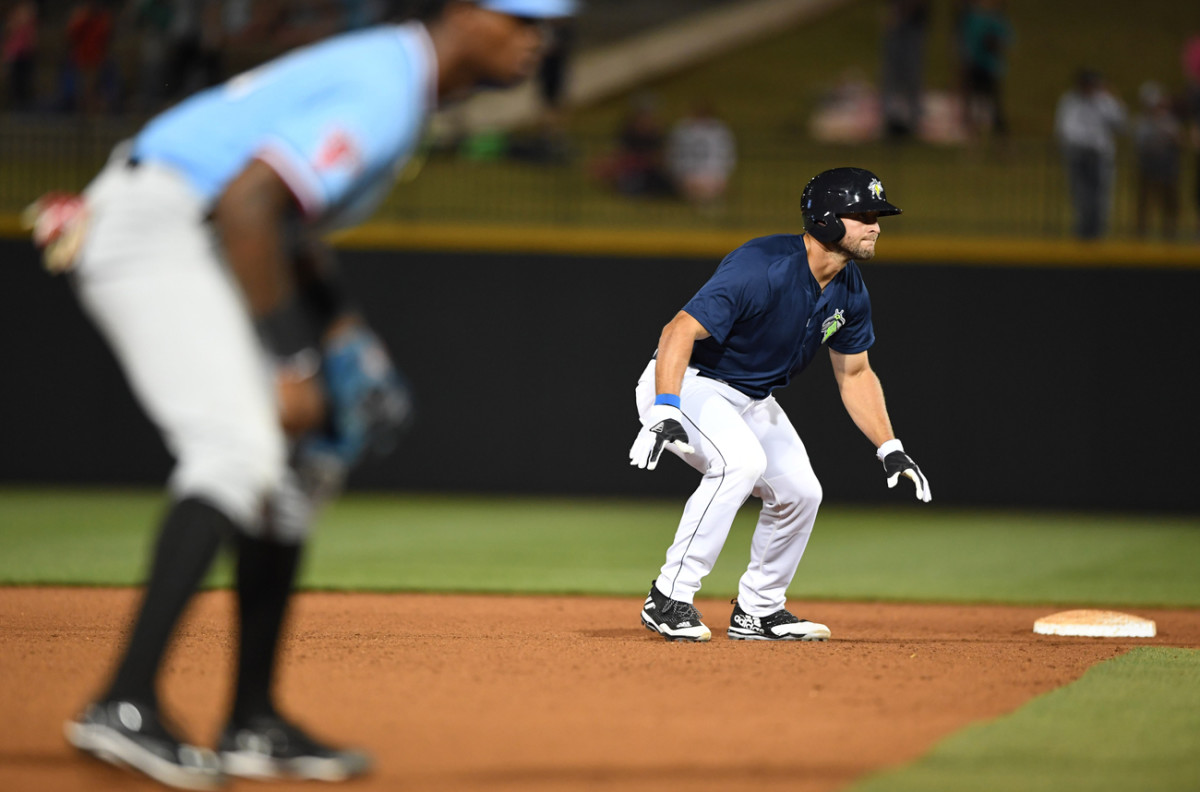
The reviews of the Showcase were not pretty. Baseball writers around the country quoted anonymous scouts—more Realists—essentially saying that Tebow had little chance of ever making the majors. “It was a complete waste of time,” one American League scout told USA Today. “It was like watching an actor trying to portray a baseball player.”
And … it didn’t matter. Teams wanted to sign Tebow anyway. Van Wagenen says that after the Showcase he heard from about 15 clubs who had some level of interest. Of those, he says, 10 told him they couldn’t handle the media circus that would accompany Tebow, and five were seriously considering making an offer. Did those five teams view Tebow as a serious baseball prospect?
“Would we have done it without the celebrity element?” Alderson says of the Mets’ signing of Tebow. “Probably not. ... So?”
Sandy Alderson, the Mets’ GM, was one of the interested parties. He saw Tebow for what he was: a famous former football player trying to play baseball, a fun experiment that a lot of people were interested in seeing. The Showcase hadn’t really swayed him.
Alderson explained his thinking like this: Say there was a scale to evaluate Tebow—at one end was signing him strictly for his baseball talent, and the other was to capitalize on the “Barnum and Bailey” effect, as Alderson put it. The Mets, he said, were “somewhere in the middle” of that scale. “The Mets have a brand,” Alderson said. “I looked at Tim as someone who wouldn’t necessarily enhance the brand; he wouldn’t degrade the brand. But he would sure expand the brand.”
So Alderson recruited Tebow hard. He promised to allow Tebow to continue with his various off-field ventures, all while supporting him on the field and giving him as many reps as needed. Alderson offered a $100,000 signing bonus, and Tebow signed on, believing that the Mets were fully behind him. Now, Alderson asked, “Would we have done it without the celebrity element? Probably not. … So?”
* * *
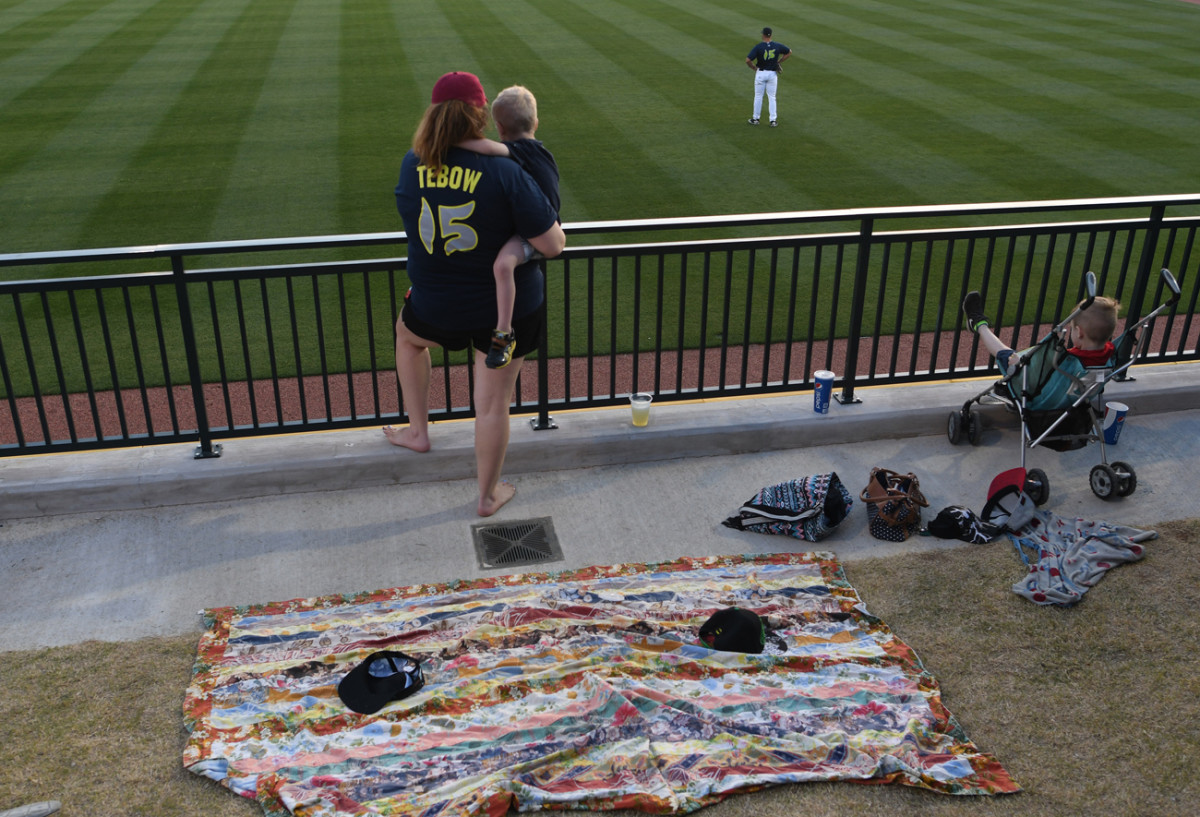
Alderson stayed true to his word. He sent Tebow to instructional league and then the Arizona Fall League—where teams send their best prospects—hoping it would speed up his development. There, Tebow worked extensively with Kevin Long, the Mets’ hitting coach, but he was also facing some of the top pitchers in the minors. Now came the hard part, the inevitable failure the Realists had foreseen. In 19 games, Tebow batted .194 and struck out 20 times.
But there was something noble about the way Tebow failed. He didn’t curse or yell. He let his teammates poke fun at him, even though some of them were seven and eight years younger than him. On Halloween, one guy actually came to warmups dressed as Tebow the football player. He wore a Broncos shirt with the sleeves rolled up and had “John 3:16” on his eye black and brought a football that they tossed around. When the faux Tebow threw a wobbly pass, someone shouted, “Just like the real Tebow!” And they all had a good laugh, Tebow included.
After days like that, Tebow would retreat to the batting cage with a smile on his face, wrap his hands in tape, and work on his swing some more. C’mon Tim! You’re better than this! Let’s go! The failing did not seem to be affecting his attitude.
“God’s like, ‘Wait, wait wait—I gotcha. I love you, and I’ve got a better plan than you can possibly imagine.”
The Realist wonders whether this is an act, too. But Tebow is always like this, it seems. It was just how he was raised, growing up in a Christian household with a father who was a missionary and a mother who home-schooled him. When Tebow boasted about his athletic success, his parents forced him to memorize Bible verses about humility. When he failed at something, they taught him that it wasn’t the end of the world. Every morning at the breakfast table, the Tebow children would gather around, and their father, Bob, would read them chapters from the Book of Psalms and Book of Proverbs. A lot of the readings were about Bible characters who were experiencing some sort of adversity. “So many of them would start like, ‘I’m being chased … I’m hiding in a cave …’ ” says Pam Tebow, Tim’s mother. “And then the end would be: ‘But I can trust God … but God is faithful … but God would never leave me or forsake me.’ ” And Tebow heard this for years, as he ate his fried eggs.
• NFL DRAFT TAKEAWAYS: Andy Benoit on the lessons from the 2017 draft
And so, Tebow doesn’t fear failure. He puts his trust in God. He believes that God has a plan for him—a good plan, a big plan—and he believes that everything in his life, good or bad, unfolds according to that plan. “We get to places sometimes,” Tebow says, “where we think: ‘Well, God, I know better than you, and what should’ve happened was, I should’ve won a couple of Super Bowls by now, and I should be the starting quarterback for this team.’ And God’s like, ‘Wait, wait, wait—I gotcha. I love you, and I’ve got a better plan than you can possibly imagine.’ ”
In that sense, Tebow says, failure isn’t striking out or not making the majors; failure would be not trying baseball. Now that he is trying, he’s going to try as hard as he can, until he figures out where baseball fits into the greater “plan.”
* * *
During the Arizona Fall League, as part of their agreement, Alderson also allowed Tebow to leave on the weekends for his job with ESPN’s SEC Network. Every Saturday, Tebow and a few other analysts would sit around a desk on a college campus and film SEC Nation, the network’s version of College GameDay, as a crowd of students cheered behind them. Every weekend Tebow was reliving the two national championships, the Heisman Trophy, his glory days. Every weekend he was being reminded of how easy his life could be outside of baseball.
Tebow had first entertained the thought of becoming a broadcaster in 2013, a few days after he’d been released by the Patriots, right at the start of that 18-month period when he sat out waiting as a free agent. If no NFL team wanted to sign him… ESPN, CBS, and FOX all wanted him. ESPN imagined him headlining the SEC Network, its newest venture at the time. They’d use him in promotions, put his face on billboards, feature him in commercials.
Before Tebow started, though, Stephanie Druley, the ESPN executive who hired him, arranged a meeting to review some basic ground rules. Among the items she wanted to discuss: religion. She remembers stumbling her way through their conversation. Look, I respect your faith, Tim, but, you know, it’s not everybody’s cup of tea. This is not the place for you to be, you know, preaching to folks or sharing your religious beliefs. This is about football.
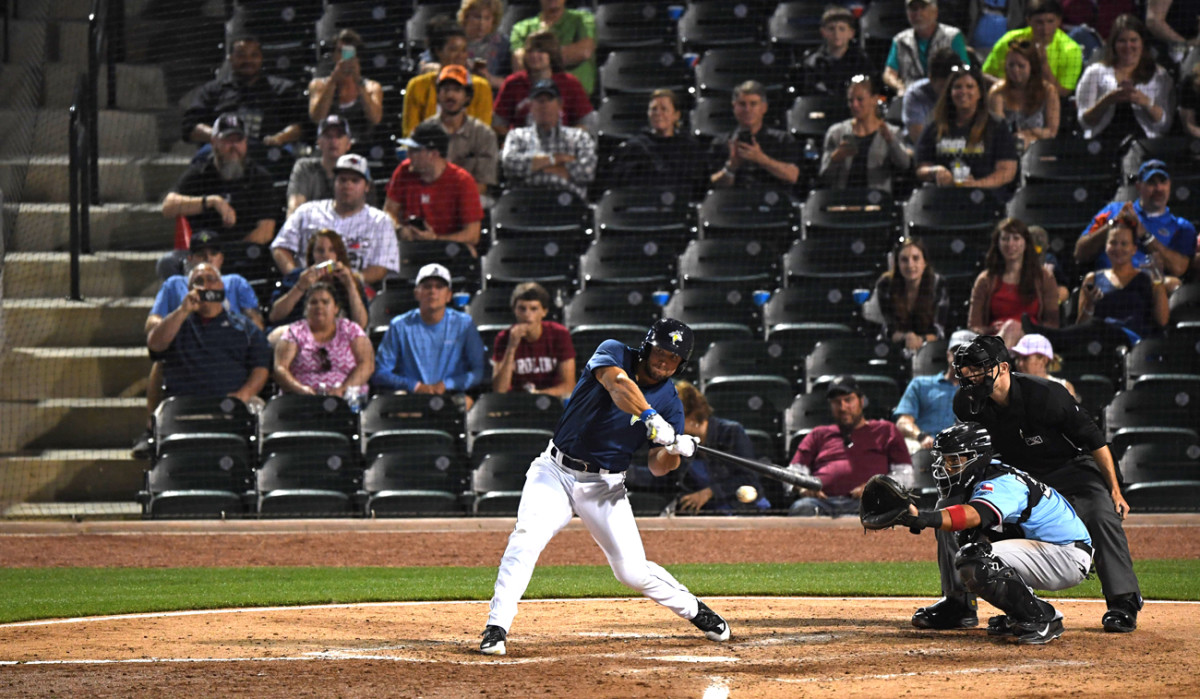
Druley was speaking for the Realist, the person who sees the Bible verses on Tebow’s eye black and hears the God references in his interviews and is … put off a bit. The Realist thinks Tebow comes across as a bit holier-than-thou, considering how often he’s in the spotlight and how conscious he seems of his brand.
Tebow nodded and assured Druley that he understood.
He is at least aware that some people feel this way about him. Every time Tebow receives a new business opportunity, he runs it by his “Circle of Trust”—a name lifted from the movie Meet the Parents—a group consisting of family and close friends. They will get on a conference call and discuss the opportunity at length, reviewing the pros and cons and, yes, the “optics”—how it would look.
There is one factor that can sway the whole debate, though. Tebow believes he has this “calling.” It comes from the same place that assures him his life is unfolding according to God’s plan. He believes that because playing football brought him great fame and a platform, he is obligated to use that platform to help others. “My biggest goal in life is to help as many people as possible,” Tebow says, and if that requires putting himself back in the spotlight, so be it.
With that in mind, Tebow pursued several public ventures while he was transitioning from football to baseball. He wrote his second book, Shaken, about coming to terms with the end of his football career. He had a stint with Good Morning America, doing segments on inspirational stories. He filmed a Fox reality show in which he gave away free homes. He traveled the country on private planes, giving speeches at schools, hospitals and churches. He had to hire a personal assistant, a former ESPN production manager named Anne Morgan, because his schedule got so busy.
Of all the things Tebow did, working for ESPN was among the most satisfying. He prepared for every show as he would a football game. He treated his fellow broadcasters like teammates. He even found a way to help people without putting off ESPN’s viewers. It involved his foundation and its W15H (pronounced “Wish”) program, which grants wishes for children with life-threatening illnesses. During his football career, Tebow these children at just about every one of his games
Now, Tebow would have a child on set, and just before SEC Nation went live, host Joe Tessitore would turn to the crowd and introduce the analysts, and then, in a grandiose, booming voice, he’d introduce the W15H child. This is Chelsea … and she’s battling cancer … and SHE IS KICKING … ITS … BUTT! Then Tebow would the child onto his shoulder, and the crowd would work itself into a frenzy, chanting. Chelsea! … Chelsea! … Chelsea!
Who cared if Tebow couldn’t hit a changeup? The SEC towns, the W15H children, the cheering crowds … Tebow decided he could keep living like this. During the fall of 2016, while he flew back and forth between the Arizona Fall League and SEC Nation, he agreed to a new multiyear deal with ESPN.
* * *
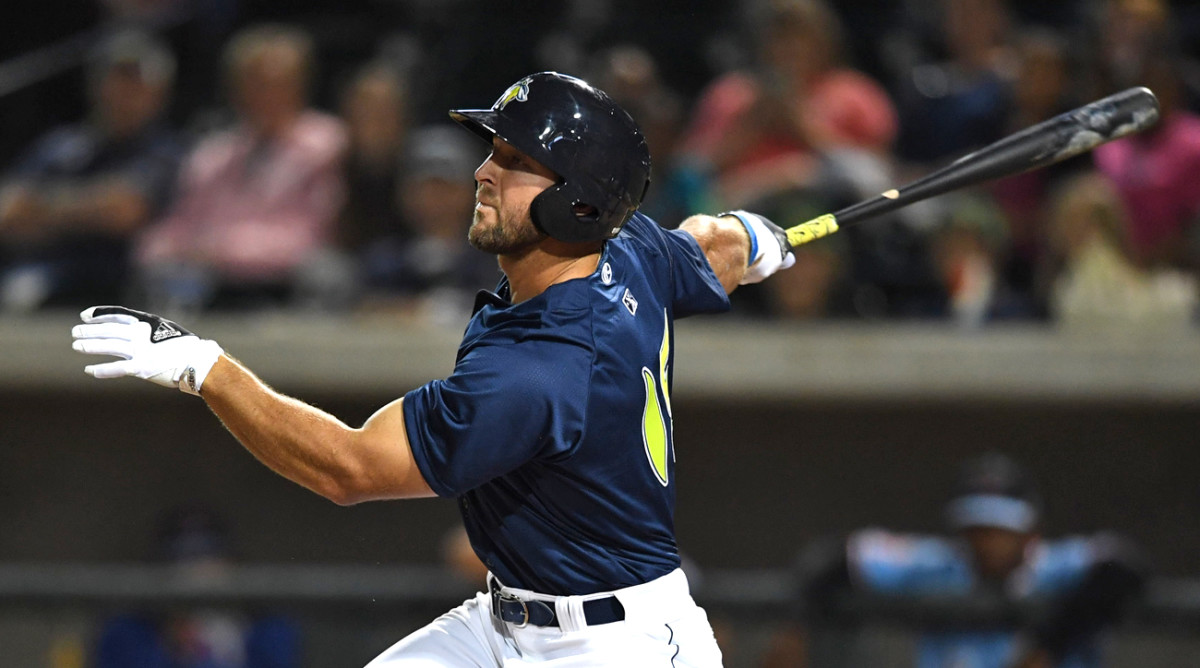
A few months later, in March 2017, Tebow walked into the clubhouse at the TPC Sawgrass Golf Course in Jacksonville wearing a salmon-colored suit, his hair coiffed. It was the night of his foundation’s seventh annual gala, which would be followed by a golf outing the next day. He walked down the red carpet, the man of the hour, smiling and shaking hands.
He had received permission to take a few days off from spring training, and perhaps he needed a break. Baseball had not gotten easier. Tebow had spent the offseason working with Chad Moeller, Kevin Long and Daniel Murphy, his neighbor in Jacksonville—and he still looked raw as a hitter. Tebow would appear in nine major league games in Mets spring training and bat .148.
Tebow had also been feeling a bit guilty. He wondered at times whether he was making the right decision, chasing his baseball dream instead of focusing on other things. His charity work, his books, his public speaking. “That’s one of my biggest struggles,” Tebow says. “Do you stop everything and go full-time foundation? Do you go live overseas and try to make a difference there? Do you just speak full-time?”
The Realist is trying to follow along here. If Tebow believes that he is called to help people, the Realist asks, how is he helping people by playing baseball? What good is he doing by striking out? Or is this a purely indulgent venture?
That night at the gala, Tebow would be giving a speech to a room full of potential charity donors—wealthy businesspeople and celebrities, about 400 in all, every one of them there to support the foundation and Tim Tebow. Midway through the program, he took the stage to a long, standing ovation, and then everyone sat down, fully attentive now, more upright in their seats. As Tebow began, he paced back and forth on the stage confidently, looking the audience in the eye. He still traveled giving speeches like this, whenever his baseball schedule would allow.
“October, 28th, 2012,” he was saying now, “I was playing for the New York Jets. … That didn’t go real well.”
Everyone laughed, and Tebow flashed a smile.
“It’s not that funny,” he said.
They laughed even harder.
Tebow composed himself and went on. He had brought up that particular day because the Jets were getting blown out and he’d been upset at his minimal playing time. He was demonstrating how his priorities had been misplaced, because, at the same time, he said, in the Philippines, a two-year-old girl named Jocy was caught in a house fire that was melting her skin. The story ended with Jocy receiving treatment from a Philippine hospital that Tebow’s foundation had funded. A picture of a healthy Jocy flashed on a screen ... and the crowd roared with applause.

This is the technique Tebow often uses in speeches now. He starts with an anecdote from his NFL career, something familiar to the audience, and he often uses it as a punchline, a way to get everyone laughing and engaged. “People can’t relate to winning a Heisman Trophy,” says Erik Dellenback, Tebow’s close friend and the president of his foundation. “But when you get punched in the face? Or cut from a team? People relate to that.” Then Tebow turns the story into something more meaningful, and he tries to leave the audience with a lesson about life.
Maybe that’s how Tebow will come to derive some sort of meaning from his baseball career. Once he’s done, he’ll have a fresh batch of stories for another round of books and speeches. He’ll travel around, telling people about the Showcase, the oblique and all of those home runs. He’ll cast himself as a role model, as someone who ignored the cynics and critics and chased his dream. “When I get to, one day—Lord willing—be 50,” Tebow says. “[I’ll] turn around and say, ‘Dang, man, I’ve been getting after it, I’ve been living life, I’ve been pursuing this.’ The stories I can tell. The life I’ve lived...”
His assistant is already scheduling speeches as far out as December 2018.
* * *
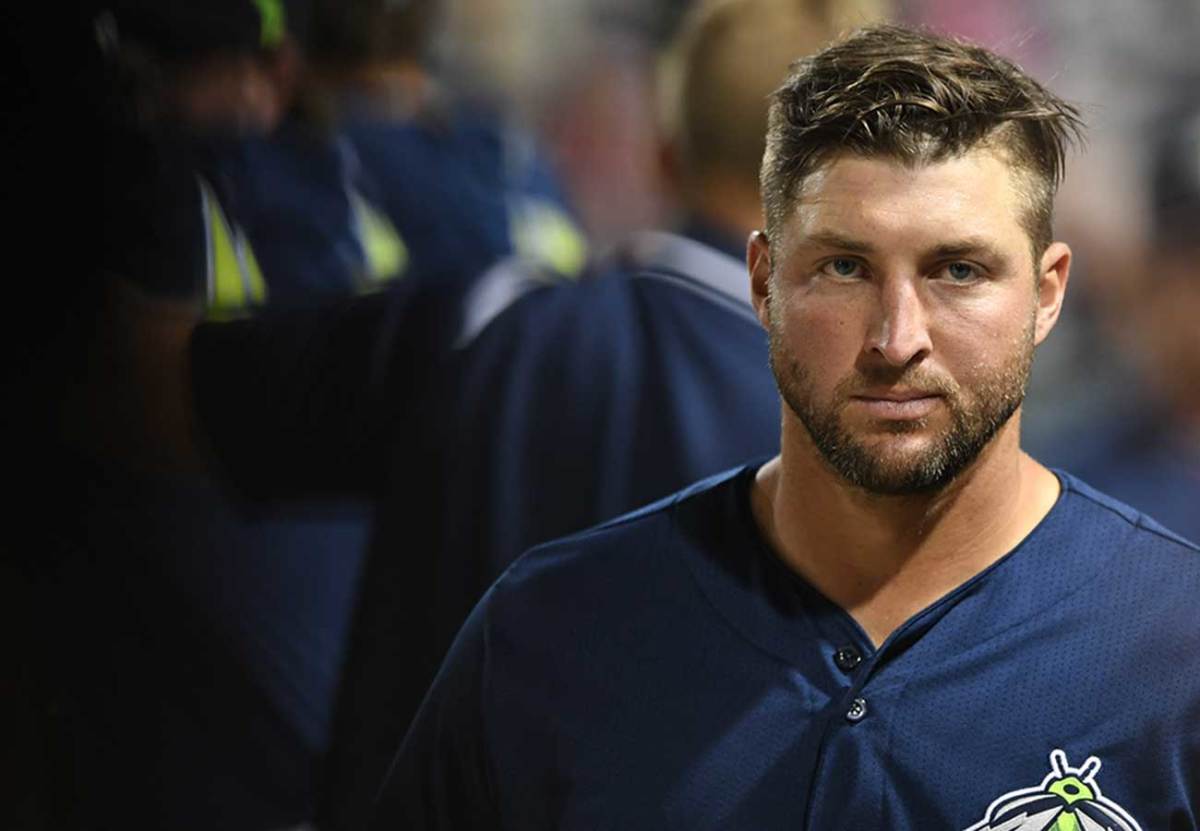
About a month later, the baseball season having officially started, Tebow was back in a batting cage working on his swing, now a member of the Columbia Fireflies. This cage was secluded, underneath the stands down the third-base line of the Fireflies’ ballpark, and Tebow was alone except for Fuentes, the hitting coach, and a park security guard who was assigned to shadow Tebow.
He was swinging off a tee, reverting to the most basic of baseball drills, as Fuentes stood a few feet away, bent over, staring at Tebow’s midsection, replacing the ball as soon as he hit it. They were working on keeping Tebow’s body square so he could make better contact.
Thwack. Thwack. Thwack.
Tebow had made his minor league debut in storybook fashion. In his first at-bat, he’d smacked a two-run home run to left-center field. A handful of children from his foundation’s W15H program were there to see it, too. Then two games later, he pulled a three-run home run to right field.
Thwack. Thwack. Thwack.
Then the novelty wore off, the spotlight faded, and here came the grind of the baseball season. The 11-hour workdays, the fielding drills, the base running tutorials, Tebow taking batting practice two, three, four times a day. He had a black knot in the palm of his right hand from how much he had been swinging, going on almost a year now. He’d come home to his condo around midnight, plop on the couch exhausted, and watch the Mets highlights from that day.
Then came the road trips, the bus rides, the real grind. Tebow’s first trip was to Augusta, Ga., about an 80-minute drive. It was a “commuter trip.” The team saved money on hotels by driving back and forth from Columbia each day.
After his first month of Single-A ball, Tebow was batting .231. He had two homers and 21 strikeouts in 22 games.
Thwack. Thwack. Thwack.
No, Tebow will probably not make the majors. But here he is anyway, back in the batting cage, chasing another childhood dream. For now, Alderson seems to be willing to let Tebow play as long as he wants—and the Realist cringes. He still doesn’t get why Tebow would put himself through it all, and so he asks, how long will Tebow keep this up, before he’s back in that conference room in the Chrysler Building, sitting around with the bigwigs at CAA, asking, What’s next?
“That’s a great question!” Tebow says, and then he smiles and shrugs and he speaks slowly so as to make himself perfectly clear. “I have no … earthly … idea.”

Question or comment? Email us at talkback@themmqb.com.
